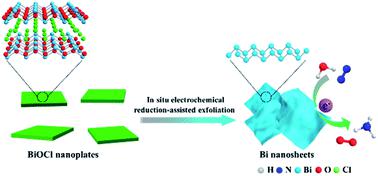当前位置:
X-MOL 学术
›
Sustain. Energy Fuels
›
论文详情
Our official English website, www.x-mol.net, welcomes your
feedback! (Note: you will need to create a separate account there.)
In situ electrochemical reduction-assisted exfoliation: conversion of BiOCl nanoplates into Bi nanosheets enables efficient electrocatalytic nitrogen fixation
Sustainable Energy & Fuels ( IF 5.0 ) Pub Date : 2020-04-28 , DOI: 10.1039/d0se00445f You Xu 1, 2, 3, 4, 5 , Tianlun Ren 1, 2, 3, 4, 5 , Shanshan Yu 1, 2, 3, 4, 5 , Hongjie Yu 1, 2, 3, 4, 5 , Shuli Yin 1, 2, 3, 4, 5 , Ziqiang Wang 1, 2, 3, 4, 5 , Xiaonian Li 1, 2, 3, 4, 5 , Liang Wang 1, 2, 3, 4, 5 , Hongjing Wang 1, 2, 3, 4, 5
Sustainable Energy & Fuels ( IF 5.0 ) Pub Date : 2020-04-28 , DOI: 10.1039/d0se00445f You Xu 1, 2, 3, 4, 5 , Tianlun Ren 1, 2, 3, 4, 5 , Shanshan Yu 1, 2, 3, 4, 5 , Hongjie Yu 1, 2, 3, 4, 5 , Shuli Yin 1, 2, 3, 4, 5 , Ziqiang Wang 1, 2, 3, 4, 5 , Xiaonian Li 1, 2, 3, 4, 5 , Liang Wang 1, 2, 3, 4, 5 , Hongjing Wang 1, 2, 3, 4, 5
Affiliation

|
The electrocatalytic nitrogen reduction reaction (NRR) for ammonia (NH3) synthesis is highly desirable yet still challenging. Catalysts, as the core component of electrocatalytic NRR systems, are a specific focus of research. In this work, we demonstrate that NRR active semimetal bismuth (Bi) ultrathin nanosheets (Bi NSs) could be prepared by means of the in situ electrochemical reduction-assisted exfoliation of BiOCl nanoplates (BiOCl NPs). Such a conversion, from semiconductive BiOCl NPs to semimetal Bi NSs, could create enlarged surface areas and bring about abundant under-coordinated Bi sites and accelerated electron transport capability. With these advantageous properties, the as-converted Bi NSs exhibit efficient NRR electrocatalytic activity in 0.1 M Na2SO4, achieving a high faradaic efficiency (14.14%) and NH3 yield (11.11 μg h−1 mgcat.−1) at −0.5 V (vs. reversible hydrogen electrode), as well as high NH3 selectivity.
中文翻译:

原位电化学还原辅助剥离:将BiOCl纳米板转化为Bi纳米板可实现高效的电催化固氮
氨(NH 3)合成的电催化氮还原反应(NRR)是非常需要的,但仍具有挑战性。催化剂作为电催化NRR系统的核心组成部分,是研究的重点。在这项工作中,我们证明了可以通过BiOCl纳米板(BiOCl NPs)的原位电化学还原辅助剥离法制备NRR活性半金属铋(Bi)超薄纳米片(Bi NSs )。从半导体BiOCl NPs到半金属Bi NSs的这种转化会产生更大的表面积,并导致大量的配位不足的Bi位置和加速的电子传输能力。具有这些有利的性能,转化后的Bi NS在0.1 M Na 2中表现出有效的NRR电催化活性SO 4,实现高的法拉第效率(14.14%)和NH 3的产率(11.11微克ħ -1毫克猫。-1 -0.5 V)(对可逆氢电极),以及高的NH 3选择性。
更新日期:2020-06-30
中文翻译:

原位电化学还原辅助剥离:将BiOCl纳米板转化为Bi纳米板可实现高效的电催化固氮
氨(NH 3)合成的电催化氮还原反应(NRR)是非常需要的,但仍具有挑战性。催化剂作为电催化NRR系统的核心组成部分,是研究的重点。在这项工作中,我们证明了可以通过BiOCl纳米板(BiOCl NPs)的原位电化学还原辅助剥离法制备NRR活性半金属铋(Bi)超薄纳米片(Bi NSs )。从半导体BiOCl NPs到半金属Bi NSs的这种转化会产生更大的表面积,并导致大量的配位不足的Bi位置和加速的电子传输能力。具有这些有利的性能,转化后的Bi NS在0.1 M Na 2中表现出有效的NRR电催化活性SO 4,实现高的法拉第效率(14.14%)和NH 3的产率(11.11微克ħ -1毫克猫。-1 -0.5 V)(对可逆氢电极),以及高的NH 3选择性。









































 京公网安备 11010802027423号
京公网安备 11010802027423号